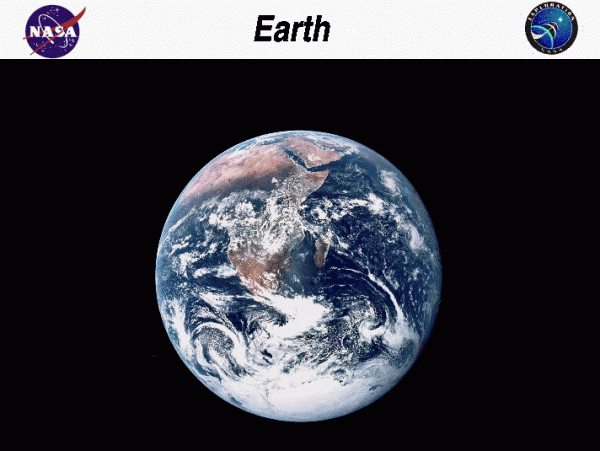Earth

Earth
The Earth is our home planet. It is the third planet from the Sun and orbits the Sun at an average distance of approximately 93 million miles (149 million km). The Earth rotates on its axis, completing one revolution every 24 hours with respect to the Sun (23 hrs. 56 min with respect to the stars). The axis of the Earth is tilted at 23 degrees and 27 minutes relative to its orbital plane about the Sun. This produces seasons on the surface of the Earth. The Earth completes one orbital revolution around the Sun in 365 days 5 hrs.
Composition of Earth
The Earth has a liquid core and a solid crust which is broken into several plates which slowly move along the surface of the planet. Approximately 70% of the surface is covered by liquid water. The mass of the Earth is approximately 6.5 x 1021 tons (5.98 x 1024 kg) and the mean diameter of the Earth is 7,926 miles (12,753 km).
The resulting surface gravitational acceleration (ge) is given by:
\(\LARGE \mathit{ge}=32.2\frac{\text{ft}}{\text{sec}^{2}}=9.8\frac{\text{m}}{\text{sec}^{2}}\)
Atmosphere of Earth
The Earth has an atmosphere composed of 78% nitrogen, 21% oxygen, and traces of other gases including carbon dioxide and water vapor. The atmosphere provides the medium for the important water cycle and life cycles that occur on the planet. The upper region of the atmosphere provides shielding from radiation from the Sun. The atmosphere also moderates the temperature extremes on the planet. Average properties of the atmosphere are given on another page.
The atmosphere is the source of aerodynamic drag on a rocket going into orbit around the Earth and provides a means for slowing spacecraft as they return from orbit. The pressure, temperature, and density of the atmosphere all decrease with altitude above the Earth’s surface. The thickness of the atmosphere is approximately 62 miles (100 km).
Earth’s Magnetic Field
The Earth has a magnetic field which protects the surface from radiation from the Sun and provides a convenient way for navigating on the surface. A single satellite, the Moon, orbits the Earth.
